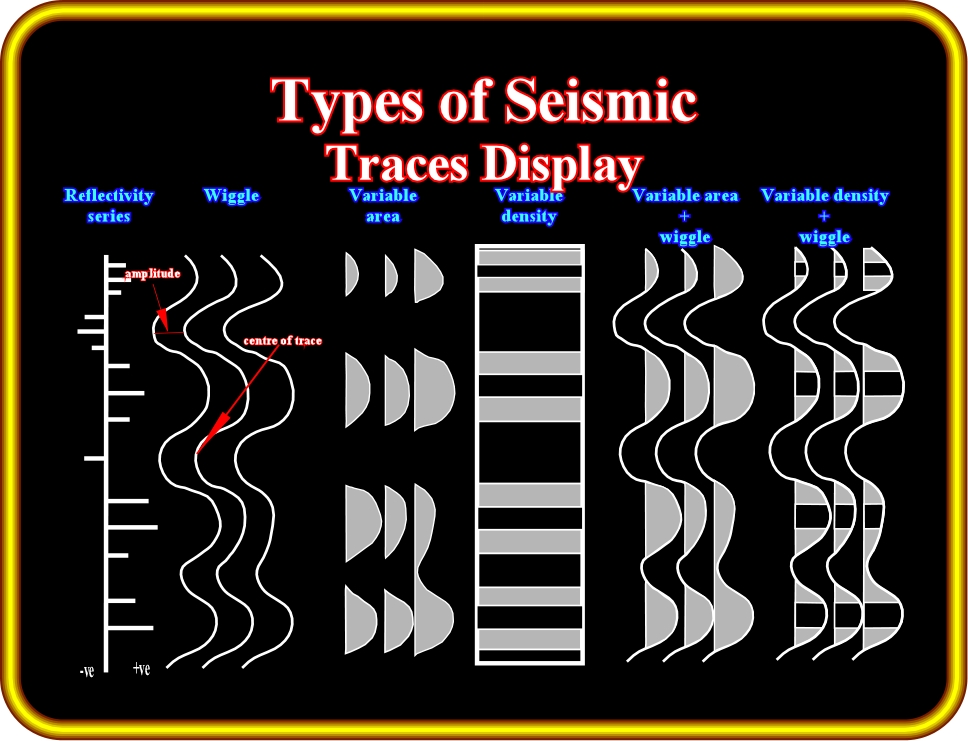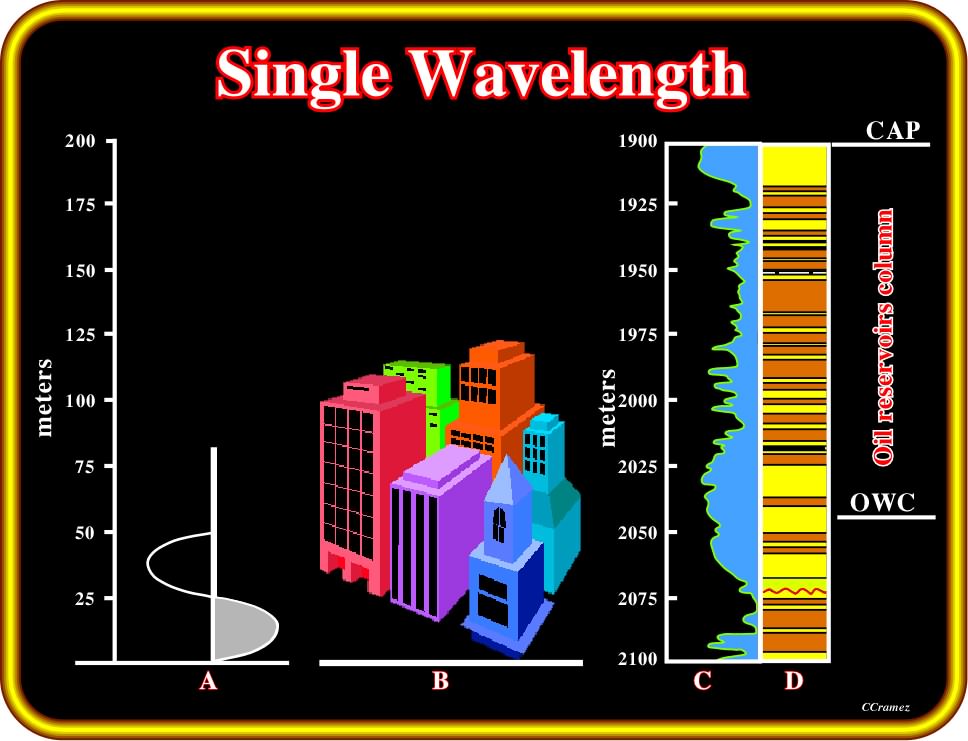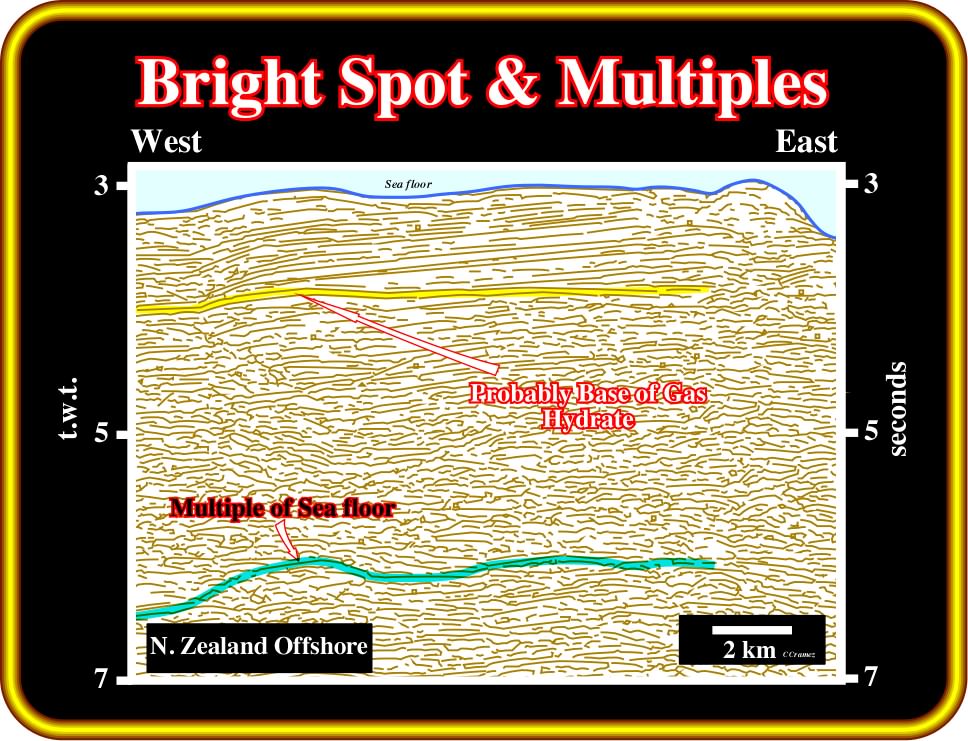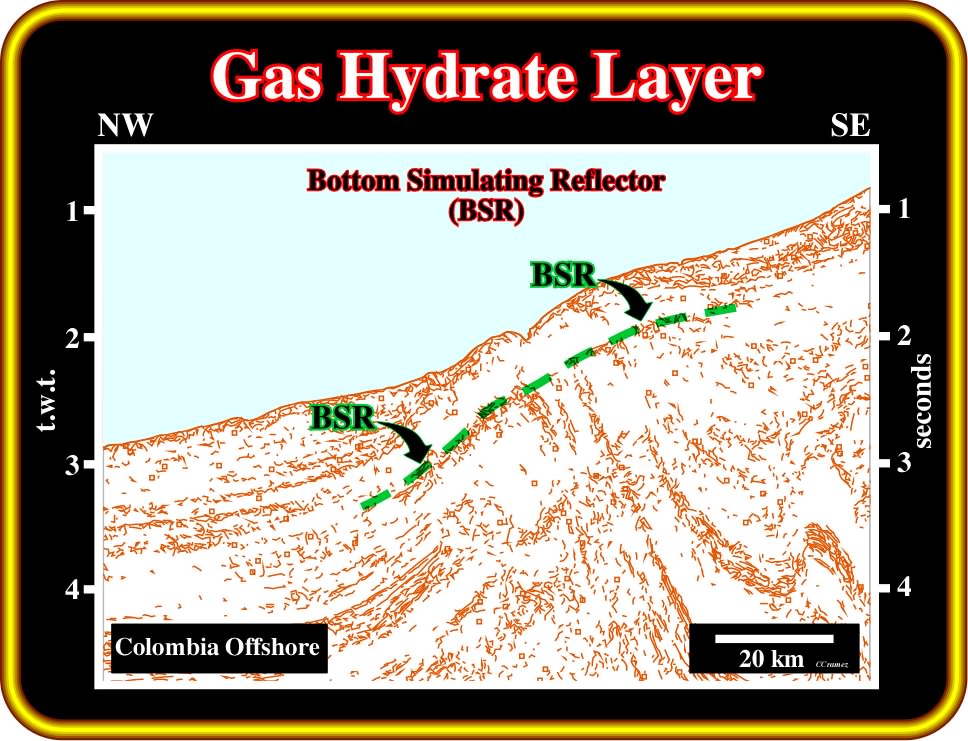

Seismic Lines
Since CDP profiling data from two-dimensional surveys are conventionally displayed as a seismic section, in which the individual stacked and migrated seismograms are plotted side by side, in close proximity, with their times axes arranged vertically. Reflection events may then be traced across the section by correlating pulses from seismogram to seismogram and in this way the distribution of surface. Reflectors beneath the survey line may be mapped. The choice of parameters governing the display of interpolation trace is critical for the final appearance of the section and for its interpretation (Plate 39).
The simplest method is to show the data as a wiggle trace, where:
- The displacement from the centre line of the trace represents reflection amplitude, and
- The deflection to the right or left of this baseline is named polarity.Alternative to the simple wiggle are:
(i) the variable area format, and
(ii) the variable-intensity.
Conventional seismic commonly uses the combination “variable area and wiggle trace” display, in which wiggle traces are superimposed on to variable area or sometimes variable-density display (Plate 26.35).

Plate 26.35- The simplest display is to show data as a wiggle trace, where the displacement from the centre line of the trace represents reflection amplitude, and polarity is expressed by deflection to the right or left of the base line. In variable area display, there is no continuous trace but the magnitude of associated values is displayed and shaded (usually in black). In variable density display, the variations in reflector strength are indicated by varied shading or different colors. Combinations of different displays are often used. Each display has its advantages and inconveniences.
On the interpretation of a seismic data, interpreters are tempting to envisage seismic sections as straightforward images of geological cross-sections, however they should not forget that:

Plate 27- Geological tentative interpretations of seismic lines require the knowledge of the global and regional geological context of the areas where they were shot. This tentative interpretation of a line shot in the Thailand offshore, must fit with the general characteristics of back-arc basins, in which a tectonic sag phase overlies a rifting phase. Geoscientists should not forget that the vertical scale is in time (two-way times) and the horizontal scale metric. On the other hand, with few exceptions, all seismic markers correspond to chronostratigraphic lines, that is to say, interfaces between relatively thin (20-60 m) sedimentary intervals. Some of these interfaces correspond to unconformities (erosional surfaces created by a significant relative sea level fall, as SB 21.0 Ma or SB. 30 Ma in this tentative) and others to downlap surfaces (see later), which separate sedimentary transgressive episodes (backstepping geometry) from regressive episodes (forestepping or progradational geometry).
Geoscientists should not forget that:
1) The vertical scale is in time and not depth.
In addition, on the tentative interpretation depicted above (Plate 27), it is important to notice that:
a) Seismic surfaces are defined by reflection terminations ;
b) The basement, in this particular instance, is an old folded belt ;
c) The geological global context is that of an episutural basin ;
d) Above the substratum, there is a back-arc basin ;
e) The back-arc basin is composed of a rifting (rift-type basin) and a sag phase ;
f) Reflectors discontinuities have been interpreted as fault planes ;
g) The more likely potential source-rocks were deposited in the rift-type basin ;
h) The potential sealing-rocks are associated with the transgressive interval of the sag phase ;
i) The chronostratigraphic calibration is based on the Vail's Neogene stratigraphic signature.
2) The seismic resolution is generally higher than 50-60 m.
A key requirement for successful application of seismic stratigraphic principles is a good understanding of the resolution of the seismic method. Generally, geological intervals thinner than 30-60 m are under the vertical seismic resolution (Plate 28).

Plate 28- This plate illustrates the vertical comparison between (A) a single cycle sine wave of 30Hz in a medium of velocity 6000 fps (or 60 Hz; 12000 fps) ; (B) Buildings and (C) Electrical log through an oil field. Geoscientists must be quite careful when proposing the interpretation of small geological bodies, as channels, point bars, etc., which in the majority of the cases are under seismic resolution. Seismic resolution is the ability to distinguish separate features, that is to say, the minimum distance between 2 features so that the two can be defined separately rather than as one. Normally, geoscientists take the resolution in the vertical sense, but there is also a limit to the horizontal width of an object that we can interpret from seismic data. The seismic "measure" is a wavelength. In order for two nearby reflective interfaces to be distinguished well, they have to be about 1/4 wavelength in thickness (Rayleigh Criterion). This is also the thickness where interpretation criteria change. For smaller thicknesses than 1/4 wavelength we rely on the amplitude to judge the bed thickness. For thicknesses larger than 1/4 wavelength we can use the wave shape to judge the bed thickness. Near the earth's surface (upper 10 meters depth), roughly, the values of velocity, frequency and wavelength (Velocity = Frequency x Wavelength.) are 1000 m/s, 100 Hz, wavelength = 10 m, while in deep earth, (5000 meter depths) they are 5000 m/s, 20 Hz, wavelength= 250 m. In other words, geoscientists can recognize a given geological body near surface but not in the deep parts. This is particularly true in deltaic environments. In fact, as the thickness of a delta (not a stacking of deltas) is hardly more than 60 meters, the recognition of deltaic progradations is probable in the uppermost levels of a seismic line but not in the deep parts. Actually, in the majority of the cases, when a geoscientist recognizes a progradational interval, at 2-3 seconds depth, the progradaitions correspond rather to continental slopes than deltaic slopes.
All interpreters need to take into account both vertical and lateral resolution:
- Vertical resolution ;
It can be defined as the minimum vertical distance between two interfaces needed to give rise to a single reflection that can be observed on a seismic section. This is governed by the wavelength of the seismic signal.
- Lateral resolution ;
It is determined by the radius of the Fresnel zone, which itself depends on the wavelength of the acoustic pulse and depth of the reflector. Seismic energy travels through the subsurface and comes into contact with the reflecting surfaces over discrete areas much in the same way that a spotlight travel through the darkness and illuminates a particular area. The energy travels as wave fronts, and the region on the reflector, where the seismic energy is reflected constructively, is known as Fresnel zone.
In non-migrated seismic data, lateral resolution is dependent on:
(i) Seismic bandwidth ;
(ii) Interval velocity ;
(iii) Travel time to the reflector.
The procedure of migrating seismic data considerably enhances resolution. However, for two-dimensional migration there is still the problem of the line orientation relative to actual dip. This is resolved on 3D data.
For migrated data, lateral resolution depends on:
(i) Trace spacing ;
(ii) Length of the migration operator ;
(iii) Time/depth of the reflector ;
(iv) Bandwidth* of the data.
* The bandwidth is the measure of the width of a range of frequencies, measured in hertz
In fact, the frequency of reflected signals decreases with increasing time/depth (t.w.t.). The main causes of this effect are:
A) Absorption
Absorption is essentially a loss of energy by conversion into heat. We can picture this happening on the microscopic scale:
Particle motion during passage of the seismic wave causes grains to slide against one another, and friction between the grains causes energy loss.
In a given rock, there is generally a constant fractional energy loss per cycle of the seismic wave. There is a constant fractional loss per wavelength.
Higher frequencies are attenuated more than lower ones over a given path. High frequencies will be quite strongly absorbed in traversing a path typical of reflection prospecting, leaving a signal whose dominant frequencies are a few tens of Hz. Earth is a low-pass filter.
B) Effect of short-period multiples
On the earth there is a good deal of layering between the source and the deep reflector. A signal can therefore bounce backward and forward between any two reflectors including land surface, seabed and sea surface a number of times, and perhaps arrive back at the receiver at nearly the same time as the deep reflector signal. These secondary signals or multiples must be eliminated from our record. Short-period multiples also cause a decrease of frequency with travel-time.
Briefly, part of the seismic energy is delayed on its path by reverberation (persistence of energy in a particular space after the original source is no longer) between closely spaced reflecting interfaces. Thus an initially sharp pulse (even if we could produce one) will be smeared out in its passage trough the earth, in effect leading to a slow decrease of frequency with depth.
3) Reflections are not always chronostratigraphic lines
The great majority of the seismic markers correspond to chronostratigraphic lines. Such analogy was recognized by the Exxon's geophysicists, which conceived seismic stratigraphy. Peter Vail summarized the origin of the birth of seismic stratigraphy as follows:
“When Exxon in the 60‘s explored the offshore Portuguese Guinea (now Guinea Bissau) three wells had been drilled. The most landward well had hit the top of major Cretaceous reservoir sand, overlying an unconformity with Paleozoic rocks below. When the second well was drilled down-dip, it was predicted that this sand would be high in the well, but it was actually encountered much lower. As a result, it was a dry well. A similar experience occurred in the third well. Then Exxon explorationists looked at the seismic section, and saw that the reflection from the top of the sand in the first well was two reflection above the reflection of the top of the sand in the second well and even higher in the third well. There was no miscorrelation of the seismic data with the well-logs and the micropaleontologists confirm that the seismic reflections were following the time lines. The pattern correlation of the well-log marker horizons showed that the real physical surfaces cross the facies of time-transgressive rock units, suggesting that the seismic reflections do not follow massive time transgressive formational boundaries where strong impedance occur, but instead they follow the detailed bedding pattern or the real physical surfaces in the rocks. Thus, they cross time-transgressive facies and rock-formation boundaries, which are not continuous physical surfaces. At the time, this was revolutionary basic driving concept. It provided a new driving concept for interpreting seismic data”.
However, on a seismic line, it is common to recognize seismic markers that do not correlate with chronostratigraphic lines (Plate 29).

Plate 29- This tentative interpretation of seismic line from New Zealand offshore shows a bright spot (in yellow), which can be interpreted as the lower surface of a gas hydrate accumulation (mineral compound CH4 and water). Basal hydrate reflectors commonly occur in sub-bottom depth, with increasing water depth, because of decreasing temperature of water above the sea floor. The term bright spot is used to named a seismic amplitude anomaly or high amplitude that can indicate the presence of hydrocarbons. They result from large changes in acoustic impedance and tuning effect (tuning is the process a system to to improve performance). For instance, the tuning of a receiver or an oscillato (adjusting to a desired frequency)., such as when a gas sand underlies a shale, but can also be caused by phenomena other than the presence of hydrocarbons, such as a change in lithology. Amultiple reflection of the sea floor is probably at around 6 seconds (t.w.t.).
Among the non-chronostratigraphic reflectors, we can differentiate
- Multiple reflections, reverberation or simply multiples ;
- Ghost reflections ;
- Water layer reverberations ;
- Short-path multiples ;
- Long-path multiples ;
- Bright spots (Plate 29), Bottom Reflectors (Plate 30), etc.

Plate 30- On this tentative interpretation (the reflectors are underlined by small strokes) of seismic line from offshore Colombia, a bottom simulator reflector is easily recognized. The gas hydrate stability zone (GHSZ) occurs in oceanic sediments over the first few hundred meters below sea floor. In this zone, any methane from organic material, including any seepage from below, is converted into solid hydrate, and is locked in place in the sediments. The origin of the methane is poorly understood, with even its biogenic origin being challenged. There are three main areas of gas hydrate occurrences : (i) The regions of continuous onshore permafrost ; (ii) The regions of subsea permafrost within the arctic shelves and (iii) The oceanic regions of the outer continental margin. The first and the third regions are currently characterized by fairly stable conditions. Due to gas hydrate stability zone dynamics, changes in the concentration of greenhouse gases can be initiated more likely in the region of continental shelves with gas hydrates (http://www.cgc.uaf.edu/Newsletter/gg4_2/gas.html).
Particular care must be taken to distinguish gas hydrates bottom reflectors from ordinary seabed multiples (Plate 29). On this subject it is interesting to summarize the composition, occurrence and economic significance of gas hydrates (Selley, R., 1998):
- Gas hydrates are compounds of frozen water that contain gas molecule ;
- The ice molecules themselves are referred to as clathrates ;
- Physically, hydrates look similar to white, powdery snow and exhibit two types of unit structure;
- They occur only in very specific pressure temperature conditions ;
- The pressure required for stability increasing logarithmically for linear thermal gradient ;
- They are stables at high pressures and low temperatures ;
- The pressure required for stability increasing logarithmically for linear thermal gradient ;
- Gas hydrates have been found in sediments of many oceans around the world ;
- They have been recognized from bright spots on seismic lines in water depths of 1000 to 2500 m (N. Sea) and in water depths of 1000 to 4000 m (North Atlantic);
Gas hydrates have been attributed to a shallow biogenic source. However, a crustal inorganic origin has been postulated, based on analysis of their carbon and helium isotope ratios:
- It is probable that methane comes from three sources:
(i) Some may be derived from the mantle ;
(ii) Some may be derived from the thermal maturation of kerogen ;
(iii) Some may be derived from bacterial degradation of organic matter at shallow burial depths.- The presence of gas hydrates can be suspected, but not proved from seismic data ;
- The lower limit of hydrate-cemented sediment is often concordant with bathymetry (Plate 29 & 30 ;
- The velocity contrast between the gas-hydrate cemented sediment and underlying non cemented sediment is large enough to generate a detectable reflection horizon ;
- The bottom-simulating reflector (BSR) may appear as a bright spot, which cross cuts bedding-related reflectors ;
- The presence of gas hydrates can only be proved, however, by engineering data. They have high resistivity and acoustic velocity, coupled with low density.
- Detailed studies have been carried out on 12 selected areas of known gas occurrence. These studies have revealed that these areas contain well in excess of 100.000 Tcf of gas within the hydrate cemented sediment, and more than 4.000 Tcf of gas trapped beneath the hydrate seal (Selley, 1998) ;
Estimated Gas Resources in Gas Hydrates
(Krason, J, 1994)
Area studied.....................................................................1 m hydrate zone
Tcf................................m3
Offshore Labrador--------------------------------------------------25-------------------------0,71 T
Baltimore Canyon---------------------------------------------------38-------------------------1,08 T
Blake Outer Ridge--------------------------------------------------66-------------------------1,88 T
Gulf of Mexico-------------------------------------------------------90-------------------------2,57 T
Colombia Basin----------------------------------------------------120-------------------------3,42 T
Panama Basin--------------------------------------------------------30-------------------------0,85 T
Middle America Trench-------------------------------------------92-------------------------2,62 T
Northern California--------------------------------------------------5-------------------------0,14 T
Aleutian Trench-----------------------------------------------------10-------------------------0,28 T
Beaufort Sea--------------------------------------------------------240-------------------------6,85 T
Nankai Trough-------------------------------------------------------15------------------------0,42 T
Black Sea---------------------------------------------------------------3-------------------------0,08 T
Send E-mail to carloscramez@gmail.com with questions or comments about these notes (Seismic-Sequential Stratigraphy).- Unfortunately, gas hydrates present considerable production problems that have yet to be overcome. These problems are due, in part, to the low permeability of the reservoir and, to chemical problems concerning the release of gas from deep crustal zones ;
- Clathrates deposits may be of indirect economic significance, however, by acting as cap rocks ;
- Because of their low permeability, they form seals that prevent the upward movement of free gas ;
- Some gas is produced from gas hydrates in western Siberia, where they pose some interesting engineering problems.
- Gas hydrates may have considerable importance in understanding climatic changes ;
- Relative sea level falls can induce sudden release of gas may trigger mud volcanoes and pock-marks on the sea bed, pingos in permafrost, as well as large turbiditic currents ;
- The huge increase of greenhouse gas into the atmosphere may be responsible for the sudden increase in global temperature and carbonate deposition (Gaia Theory).